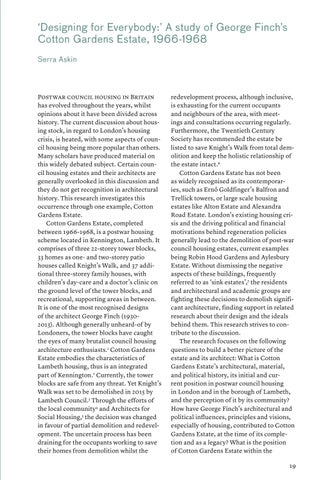‘Designing for Everybody:’ A study of George Finch’s Cotton Gardens Estate, 1966-1968 Serra Askin
POSTWAR COUNCIL HOUSING IN BRITAIN has evolved throughout the years, whilst opinions about it have been divided across history. The current discussion about housing stock, in regard to London’s housing crisis, is heated, with some aspects of council housing being more popular than others. Many scholars have produced material on this widely debated subject. Certain council housing estates and their architects are generally overlooked in this discussion and they do not get recognition in architectural history. This research investigates this occurrence through one example, Cotton Gardens Estate. Cotton Gardens Estate, completed between 1966-1968, is a postwar housing scheme located in Kennington, Lambeth. It comprises of three 22-storey tower blocks, 33 homes as one- and two-storey patio houses called Knight’s Walk, and 37 additional three-storey family houses, with children’s day-care and a doctor’s clinic on the ground level of the tower blocks, and recreational, supporting areas in between. It is one of the most recognised designs of the architect George Finch (19302013). Although generally unheard-of by Londoners, the tower blocks have caught the eyes of many brutalist council housing architecture enthusiasts.1 Cotton Gardens Estate embodies the characteristics of Lambeth housing, thus is an integrated part of Kennington.2 Currently, the tower blocks are safe from any threat. Yet Knight’s Walk was set to be demolished in 2015 by Lambeth Council.3 Through the efforts of the local community4 and Architects for Social Housing,5 the decision was changed in favour of partial demolition and redevelopment. The uncertain process has been draining for the occupants working to save their homes from demolition whilst the
redevelopment process, although inclusive, is exhausting for the current occupants and neighbours of the area, with meetings and consultations occurring regularly. Furthermore, the Twentieth Century Society has recommended the estate be listed to save Knight’s Walk from total demolition and keep the holistic relationship of the estate intact.6 Cotton Gardens Estate has not been as widely recognised as its contemporaries, such as Ernő Goldfinger’s Balfron and Trellick towers, or large scale housing estates like Alton Estate and Alexandra Road Estate. London’s existing housing crisis and the driving political and financial motivations behind regeneration policies generally lead to the demolition of post-war council housing estates, current examples being Robin Hood Gardens and Aylesbury Estate. Without dismissing the negative aspects of these buildings, frequently referred to as ‘sink estates’,7 the residents and architectural and academic groups are fighting these decisions to demolish significant architecture, finding support in related research about their design and the ideals behind them. This research strives to contribute to the discussion. The research focuses on the following questions to build a better picture of the estate and its architect: What is Cotton Gardens Estate’s architectural, material, and political history, its initial and current position in postwar council housing in London and in the borough of Lambeth, and the perception of it by its community? How have George Finch’s architectural and political influences, principles and visions, especially of housing, contributed to Cotton Gardens Estate, at the time of its completion and as a legacy? What is the position of Cotton Gardens Estate within the 19
